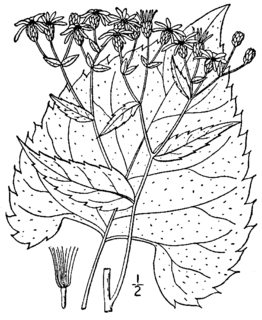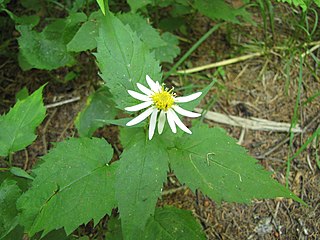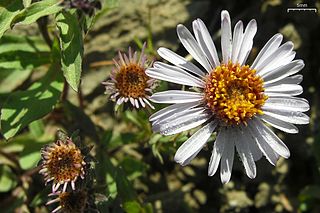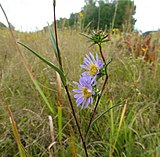
Eurybia macrophylla, commonly known as the bigleaf aster, large-leaved aster, largeleaf aster or bigleaf wood aster, is an herbaceous perennial in the composite family that was formerly treated in the genus Aster. It is native to eastern North America, with a range extending from eastern and central Canada through the northeastern deciduous and mixed forests of New England and the Great Lakes region and south along the Appalachians as far as the northeastern corner of Georgia, and west as far as Minnesota, Missouri and Arkansas. The flowers appear in the late summer to early fall and show ray florets that are usually either a deep lavender or violet, but sometimes white, and disc florets that are cream-coloured or light yellow, becoming purple as they mature. It is one of the parent species of the hybrid Eurybia × herveyi.

Liatris pycnostachya, the prairie blazing star or cattail blazing star, is a perennial plant native to the tallgrass prairies of the central United States.

Eurybia divaricata, commonly known as the white wood aster, is an herbaceous plant native to eastern North America. It occurs in the eastern United States, primarily in the Appalachian Mountains, though it is also present in southeastern Canada, but only in about 25 populations in the provinces of Ontario and Quebec. In the U.S. it is abundant and common, but in Canada it is considered threatened due to its restricted distribution. It can be found in dry open woods as well as along wood-edges and clearings. The species is distinguished by its flower heads that have yellow centers and white rays that are arranged in flat-topped corymbiform arrays, emerging in the late summer through fall. Other distinguishing characteristics include its serpentine stems and sharply serrated narrow heart-shaped leaves. The white wood aster is sometimes used in cultivation in both North America and Europe due to it being quite tough and for its showy flowers.

Eurybia is a genus of plants in the composite family that were previously included in the genus Aster. Most species are native to North America, although one is also present in northern Eurasia. There are 23 species in the genus, including 1 natural hybrid. The name was first applied by Alexandre de Cassini in 1820. The name is derived from Ancient Greek εὐρύς (eurús), meaning "wide", and βαιός (baiós), meaning "few", perhaps in reference to the small number of relatively wide ray florets.

Eurybia schreberi, commonly called Schreber's aster or nettle-leaved Michaelmas-daisy, is a perennial herb in the composite family. It is native to eastern North America, where it is present in Canada and the United States. The flower heads emerge in the late summer or early fall to show white ray florets and yellow disc florets. It is listed as endangered in Indiana and Iowa, of special concern in Tennessee and possibly extirpated in Maine.
Eurybia spinulosa, commonly called the Apalachicola aster or pinewoods aster, is a perennial herb in the composite family. It is native to the south eastern United States, where it is present only in the Florida panhandle. Due to its restricted habitat, which is confined to the Apalachicola river drainage, as well as to ongoing development in these areas, the species is of serious conservation concern. It has been listed as critically imperiled by the Nature Conservancy and endangered by the state of Florida.

Eurybia spectabilis, commonly known as the eastern showy aster, simply showy aster or purple wood aster, is an herbaceous perennial native to the eastern United States. It is present along the coastal plain of the U.S. where it is most often found growing in dry, sandy soils. Although it is not considered threatened due to its extensive range, it is locally endangered in many states. The flowers appear in the fall and show ray florets that are a violet-purple and yellow disc florets. It is one of the parent species of the hybrid Eurybia × herveyi.

Eurybia chlorolepis, commonly known as the mountain wood aster, mountain aster, or Appalachian heartleaf aster, is a perennial, herbaceous plant native to the southeastern United States. It is present only at relatively high elevations in the Appalachian mountains. Although it is not considered seriously threatened due to a large number of sites in some of its range, it is often locally endangered and possibly extirpated in the south of its range.

Eurybia sibirica, commonly known as the Siberian aster or arctic aster, is an herbaceous perennial native to north western North America and northern Eurasia. It is found largely in open areas of subarctic boreal forests, though it is also found in a wide variety of habitats in the region. It is similar in appearance to Eurybia merita, but their ranges overlap only near the border between the US and Canada, where E. sibirica is generally found at higher elevations.

Eurybia compacta, commonly known as the slender aster, is an herbaceous perennial native to the eastern United States from New Jersey to Georgia. It is commonly found along the coastal plain in dry sandy soils, especially in pinelands. While it is not considered to be in high danger of extinction, it is of conservation concern and has most likely been extirpated from much of its original range. The slender aster was for a long time considered to be a variety of E. surculosa, but Guy Nesom's recent research within the genus has shown that it is distinct enough to be treated as a species. It has also been shown to be related to E. avita and E. paludosa.

Eurybia conspicua, commonly known as the western showy aster, is a North American species of plants in the composite family. It is native to western Canada and the western United States.

Eurybia furcata, commonly called forked aster, is an herbaceous perennial in the composite family. It is native primarily to the Great Lakes region and the Ozark Mountains in the United States. It is uncommon throughout its range, and occurs in the states of Michigan and Wisconsin in the north, south through Nebraska, Illinois, Iowa, and Indiana, and into Missouri and Arkansas. The species is intolerant of shade and is typically found on rocky, north-facing slopes, especially those composed of limestone, dolomite, or sandstone. It can also be found in seeps on bluffs, in moist woods along streams, and occasionally in disturbed sites. It is included in the Center for Plant Conservation's National Collection of Endangered Plants.

Eurybia radula, commonly known as the low rough aster or rough wood aster, is an herbaceous perennial in the aster family. It is native to eastern North America where it is present from Newfoundland and Labrador in the far northeast of Canada, west to Ontario and south to Kentucky and Virginia in the United States. The low rough aster is also present on the French overseas territory of St. Pierre and Miquelon just south of Newfoundland. It typically grows in wet soils in a wide variety of habitats from bogs and fens to creek shores to ditches. Although it is not considered threatened over most of its distribution, it is imperiled or possibly extirpated over much of its range in the United States. Its flower heads emerge in the late summer to early fall and show pale blue-violet rays with yellow centres.
Eurybia paludosa, commonly known as the southern swamp aster, is an herbaceous perennial in the aster family. It is native to the southeastern United States where it is confined to the Carolinas and the states of Georgia and Florida. It is generally confined to moist soils, though it can occasionally be found on sand hills along the coastal plain. The southern swamp aster is often confused with the closely related southern prairie aster, though they do not occur in the same habitats or geographical areas. Its flower heads emerge in the late summer through fall and show deep lavender to purple rays with yellow centres.
Eurybia mirabilis, commonly known as the bouquet aster or dwarf aster, is an herbaceous perennial in the aster family. It is endemic to the lower Piedmont of North Carolina and South Carolina in the southeastern United States. Within this small range it is found only infrequently, making it of conservation concern. The species is now largely confined to inaccessible bluffs due to the conversion of other habitats to farmland. It typically grows in deciduous or mixed deciduous woods, as well as on slopes or alluvial plains. Basic to neutral soils are usually preferred. Its flower heads emerge in the late summer to early fall and show white to lavender rays with pale yellow centres sometimes tinged with purple.

Eurybia merita, commonly known as the subalpine aster or arctic aster, is an herbaceous perennial native to northwestern North America, primarily from the Interior Mountains and Plateau system and Rocky Mountains in Canada, stretching south to Utah and extreme northern California. It is found largely in drier, open areas, generally at subalpine levels in mountains, though in more northern areas it is more common at lower elevations. It is similar in appearance to Eurybia sibirica, but their ranges only overlap near the border between the US and Canada, where E. sibirica is generally found at higher elevations than its relative. The flowers emerge in the late summer and display purple to violet ray florets and pale or creamy yellow disc florets.
Eurybia jonesiae, commonly known as Jones's aster or Almut's wood aster, is a North American species of herbaceous perennial native to the Southeastern United States, primarily in the state of Georgia with a few populations in eastern Alabama. It is found mostly in the Piedmont Region in rich oak-hickory-pine forest. Within these rich woods, it has an affinity for moist soils with habitats that include ravines, rocky ridges, and wooded slopes in the vicinity of rivers and streams. Due to its restricted range it is considered threatened by the Nature Conservancy. It has often been misidentified as Eurybia spectabilis and was declared a separate species quite recently in 1988. The flowers emerge in the late summer and persist into the fall bearing cream-coloured ray florets that become purple and yellow disc florets.
Liatris bracteata, commonly known as the bracted blazing star, or South Texas gayfeather, is a species of flowering plant in the aster family, Asteraceae. It is native to Texas in the United States, where it is found in coastal prairies, roadsides, and along railroads with clay or sandy loam soils. This species is of conservation concern in its native range.

Liatris elegans, known commonly as pinkscale gayfeather, pinkscale blazingstar, and elegant blazingstar, is a species of flowering plant in the aster family, Asteraceae. It is native to the southeastern United States as far west as Texas and Oklahoma.

Ratibida pinnata is a species of flowering plant in the family Asteraceae known by the common names pinnate prairie coneflower, gray-head coneflower, yellow coneflower, and prairie coneflower. It is native to the central and eastern United States and Ontario in Canada.
















